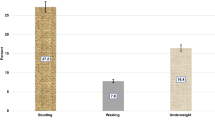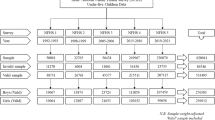Abstract
Background/Objectives:
Various nutrition programs and free health care for children less than 6 years old were introduced in South Africa in the mid-1990s. We aim to describe secular trends for nutritional status of South African (SA) children in the 10-year period following these reforms.
Subjects/Methods:
The SA National Primary Schools’ Anthropometric Survey (n=105 000) is a cross-sectional survey of children from all SA Education Departments sampled during 1994. The Health of the Nation Study (n=10 295) is a cross-sectional study, including children from primary schools in five SA Provinces sampled from 2001 to 2004. Height and weight of SA children were measured during both surveys. In 8–11 year olds, the National Centre for Health Statistics reference was used to calculate the prevalence of mild and moderate stunting, and overweight and obesity were calculated according to the International Obesity Task Force reference. Coexistence of stunting, overweight and obesity among these two age- and sex-matched cohorts were also calculated.
Results:
When compared with previous SA data, moderate stunting (24.6–4.9%, P<0.001) decreased over the 7–10 years considered, whereas overweight (1.2–13.0%, P<0.001) and obesity (0.2–3.3%, P<0.001) prevalence increased. There were lower levels of mild stunting and similar levels of moderate stunting among overweight/obese children when compared with non-overweight/non-obese children.
Conclusions:
Our findings suggest that feeding policies may have been effective in reducing the prevalence of under-nutrition. However, inter-sectoral policies should recognize the apparent secular trend for an increased prevalence in overweight/obesity among young South Africans.
This is a preview of subscription content, access via your institution
Access options
Subscribe to this journal
Receive 12 print issues and online access
$259.00 per year
only $21.58 per issue
Buy this article
- Purchase on Springer Link
- Instant access to full article PDF
Prices may be subject to local taxes which are calculated during checkout


Similar content being viewed by others
References
Administrative Committee on Coordination; Sub-committee on Nutrition (ACC/SCN) and International Food Policy Research Institute (IFPRI) (2000). Fourth Report on the World Nutrition Situation. Geneva.
Armstrong MEG, Lambert MI, Sharwood KA, Lambert EV (2006). Obesity and overweight in South African primary school children, 6–13 years of age: the health of the nation study. S Afr Med J 96, 439–444.
Bellizzi MC, Dietz WH (1999). Workshop on childhood obesity: summary of the discussion. Am J Clin Nutr 70, 173S–175S.
Bourne LT, Hendricks MK, Marais D, Eley B (2007). Addressing malnutrition in young children in South Africa. Setting the national context for paediatric food-based dietary guidelines. Matern Child Nutr 3, 230–238.
CDC (2005). EpiInfo. Centers for Disease Control and Prevention: Atlanta, USA.
Cole TJ, Bellizzi MC, Flegal KM, Dietz WH (2000). Establishing a standard definition for child overweight and obesity worldwide: international survey. BMJ 320, 1240–1243.
Coutsoudis A, Coovadia HM (2001). Nutrition activities in South Africa. Nutr Res 21, 459–463.
Department of Health (1994). Anthropometric Survey in Primary Schools in the RSA. Sub-Directorate Statistical Analysis. Department of Health: Pretoria, South Africa.
Department of Health (2000). The Integrated Nutrition Programme. A Foundation for Life, Nutrition Directorate Issue. Department of Health: Pretoria, South Africa, p 2.
Department of Health (2007). Infant and Young Child Feeding Policy. Department of Health: Pretoria, South Africa.
Jinabhai CC, Taylor M, Sullivan KR (2003). Implications of the prevalence of stunting, overweight and obesity amongst South African primary school children: a possible nutritional transition? Eur J Clin Nutr 57, 358–365.
Mamabolo RL, Kruger HS, Lennox A, Monyeki MA, Pienaar AE, Underhay C et al. (2007). Habitual physical activity and body composition of black township adolescents residing in the North West Province, South Africa. Public Health Nutr 10, 1047–1056.
Mvo Z, Dick J, Steyn K (1999). Perceptions of overweight African women about acceptable body size of women and children. Curationis 22, 27–31.
Reddy SP, Panday S, Swart D, Jinabhai CC, Amosun SL, James S et al. (2003). Umthenthe Uhlaba Usamila—The 1st South African National Youth Risk Behaviour Survey 2002. Medical Research Council: Cape Town, South Africa.
Serdula MK, Ivery D, Coates RJ, Freedman DS, Williamson DF, Byers T (1993). Do obese children become obese adults? A review of literature. Prev Med 22, 167–177.
Shrimpton R, Victora CG, de Onis M, Costa Lima R, Blössner M, Clugston G (2001). Worldwide timing of growth faltering: implications for nutritional interventions. Pediatrics 107, e75.
South African Vitamin A Consultative Group (SAVACG) (1995). Children Aged 6- 71 Months in South Africa, 1994: Their Anthropometric, Vitamin A, Iron and Immunisation Coverage Status. SAVACG: Johannesburg, South Africa.
Statistics South Africa (2005). Census in Brief: 2001 Census, vol. 2. Statistics South Africa: Pretoria, South Africa, pp 12–13.
Steyn K, Schneider M (2001). In: Bradshaw D, Steyn K (eds). Poverty and Chronic Diseases in South Africa: Overview on Poverty in South Africa. Medical Research Council and World Health Organisation: Cape Town, South Africa, pp 1–13.
Steyn NP, Nel JH, Tichelaar HY, Prinsloo JF, Dhansay MA, Oelofse A et al. (1994). Malnutrition in Pedi preschool children, their siblings and caretakers. S Afr J Clin Nutr 7, 12–18.
Uauy R, Kain J (2002). The epidemiological transition: need to incorporate obesity prevention into nutrition programmes. Public Health Nutr 5, 223–229.
WHO (1995). Physical Status: The Use and Interpretation of Anthropometry: Report of a WHO Expert Committee. WHO: Geneva.
World Bank (1993). Investing in Health: World Development Report. Oxford.
Acknowledgements
The study was funded by Discovery Health; University of Cape Town, Research Unit for Exercise Science and Sports Medicine; FlipFile; Medical Research Council of South Africa; National Research Foundation; Deutscher Akadademischer Austauschdienst; and Harry Crossley and Nellie Atkinson research funds. Mr Brad Bing of Sporting Chance provided the infrastructure through which all testing was carried out.
Author information
Authors and Affiliations
Corresponding author
Ethics declarations
Competing interests
The authors declare no conflict of interest.
Rights and permissions
About this article
Cite this article
Armstrong, M., Lambert, M. & Lambert, E. Secular trends in the prevalence of stunting, overweight and obesity among South African children (1994–2004). Eur J Clin Nutr 65, 835–840 (2011). https://doi.org/10.1038/ejcn.2011.46
Received:
Revised:
Accepted:
Published:
Issue Date:
DOI: https://doi.org/10.1038/ejcn.2011.46
Keywords
This article is cited by
-
Factors associated with underweight, overweight, stunting and wasting among primary school-going children participating in a school health initiative in South Africa
BMC Nutrition (2023)
-
Prevalence, incidence, and trends of childhood overweight/obesity in Sub-Saharan Africa: a systematic scoping review
Archives of Public Health (2020)
-
Anthropometric profiles of 8–11 year old children from a low-income setting in South Africa
BMC Public Health (2019)
-
Overweight impairs efficacy of iron supplementation in iron-deficient South African children: a randomized controlled intervention
International Journal of Obesity (2013)



